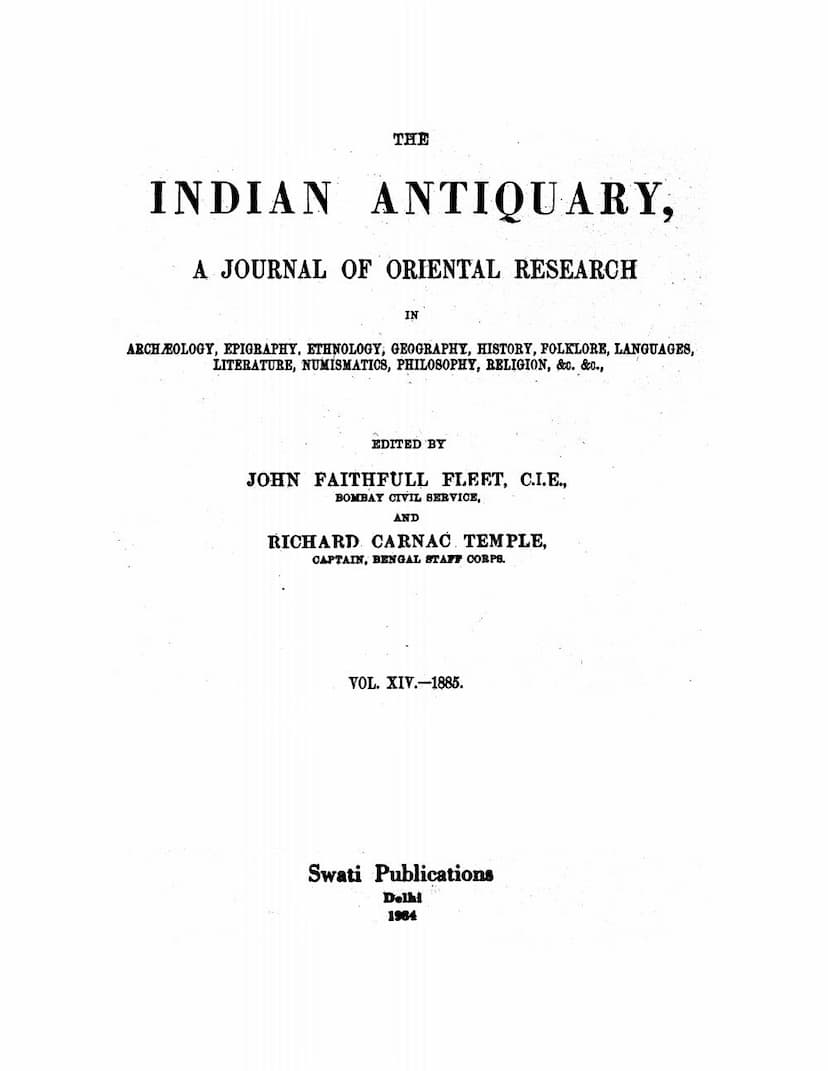Indian Antiquary Vol 14
Added to library: September 1, 2025

Summary
The Indian Antiquary, Volume 14 (1885) is a collection of scholarly articles and research papers on various aspects of Oriental studies, including archaeology, epigraphy, ethnology, geography, history, folklore, languages, literature, numismatics, philosophy, and religion. Edited by John Faithfull Fleet and Richard Carnac Temple, this volume offers a rich tapestry of historical and cultural insights into India and its neighboring regions during the 19th century.
The provided text contains several articles that touch upon Jainism, particularly in its historical and cultural context:
1. Sanskrit and Old Kanarese Inscriptions (J. F. Fleet): This ongoing series includes several inscriptions related to historical periods and dynasties. While not exclusively Jain, these inscriptions often mention Jain teachers, sects (like the Kimyaka gachchha), and practices. The article on the Byana Stone-Inscription of the Adhiraja Vijaya (Samvat 1100) specifically mentions a Sūri (Jain teacher) Maheśvara, a leader of the Svetambaras, and his lineage. It also discusses the city of Sripatha, which had Jain associations. The inscription further elaborates on the inscription at the Ukha-Mandar, which shows the temple belonged to the Jain faith in the 11th century AD.
2. An Old Kanarese Inscription at Têrdal (K. B. Pathak): This article is particularly relevant for Jain studies. It discusses a stone tablet with three parts, detailing grants made to the Jain god Nôminâtha. It mentions several well-known Jain ascetics and authors, including Guņabhadra, Pampa, Meghachandra, and Kundakunda (also called Padmanandi), and discusses their works and the period they lived in. It highlights the dispute between Brahmins and Jainas regarding sacrifices, as mentioned in the Uttarapurana. It also touches upon the philosophical concept of anekânta and its relation to Jainism.
3. A Buddhist Sanskrit Inscription from Kota (E. Hultzsch): While this article focuses on a Buddhist inscription, it provides context for the religious landscape of ancient India. It mentions the lineage of rulers, including names like Bindunaga and Padmanaga, which might have some connection to the broader religious or mythical traditions of the time, although the primary focus is Buddhist.
4. The Proverbs of Ali Ebň Abi Talebi (K. T. Best): Although this article focuses on Islamic proverbs, the inclusion of such texts in the Indian Antiquary reflects the multicultural and multi-religious scholarly discourse of the time, where even foreign religious and ethical traditions were examined within the Indian context.
5. The Gaharwars and Rathors (A. F. Rudolf Hoernle): This article discusses the history of dynasties in North India. It touches upon the religious affiliations of these rulers, noting that the Palas professed Buddhism while the Chandras were Brahmanists, which may have led to a separation and change in nomenclature (Pala to Chandra, and Gaharwar to Rathor). This hints at the interplay of religious and political factors in the formation and evolution of Indian dynasties.
Overall Significance for Jain Studies:
While the volume is not exclusively a Jain text, it provides valuable historical and linguistic data that can be used to understand the broader socio-religious context in which Jainism flourished. The mentions of Jain teachers, sects, philosophical concepts, and grants to Jain deities in the inscriptions offer direct insights into the presence and influence of Jainism during specific historical periods. The detailed analysis of inscriptions, particularly those mentioning Jain ascetics and their literature, contributes to our understanding of the historical development and preservation of Jain traditions. The discussions on the historical context of religious practices and beliefs also indirectly illuminate the environment in which Jainism evolved and interacted with other religious and philosophical systems in India.
The inclusion of these articles within a broader journal of Oriental research emphasizes the holistic approach to historical and cultural studies prevalent in the 19th century, where different religious traditions were examined within the larger framework of Indian civilization.